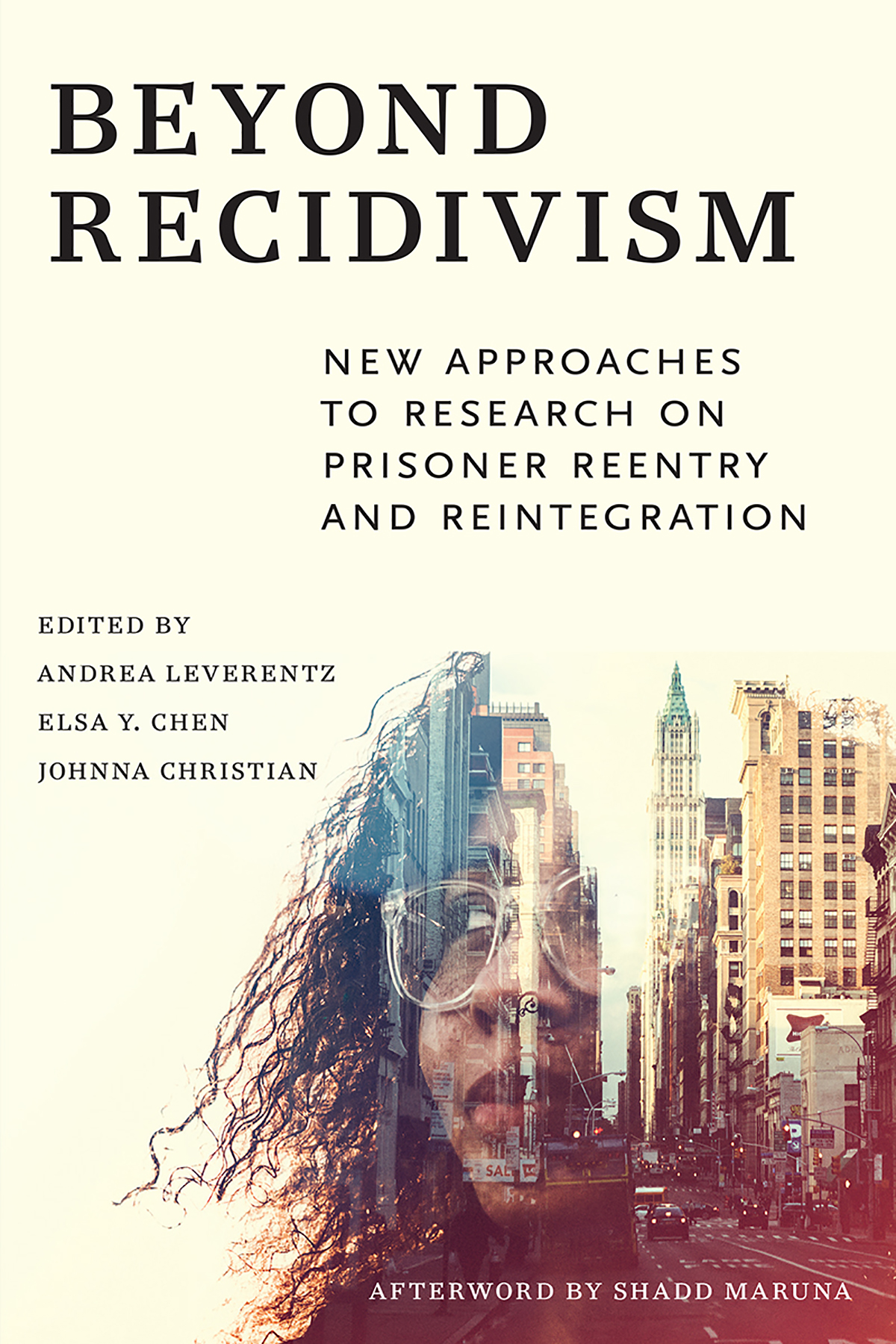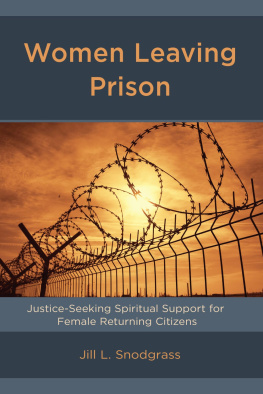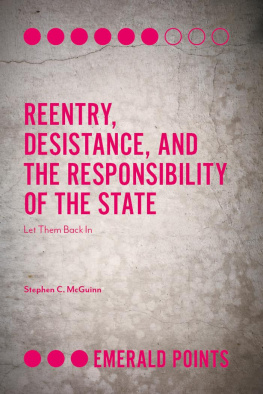Contents
Guide
Pagebreaks of the print version

BEYOND RECIDIVISM
Beyond Recidivism
New Approaches to Research on Prisoner Reentry and Reintegration
Edited by
Andrea Leverentz, Elsa Y. Chen, and Johnna Christian
With an Afterword by Shadd Maruna

NEW YORK UNIVERSITY PRESS
New York
NEW YORK UNIVERSITY PRESS
New York
www.nyupress.org
2020 by New York University
All rights reserved
References to Internet websites (URLs) were accurate at the time of writing. Neither the author nor New York University Press is responsible for URLs that may have expired or changed since the manuscript was prepared.
Library of Congress Cataloging-in-Publication Data
Names: Leverentz, Andrea M., 1973, editor. | Chen, Elsa Yee-Fang, 1970, editor. | Christian, Johnna, editor. | Maruna, Shadd, writer of afterword.
Title: Beyond recidivism : new approaches to research on prisoner reentry and reintegration / [edited by] Andrea Leverentz, Elsa Y. Chen, and Johnna Christian ; afterword by Shadd Maruna.
Description: New York : New York University Press, [2020] | Includes bibliographical references and index. | Summary: Beyond Recidivism explores new approaches to research on prisoner reentry and reintegrationProvided by publisher.
Identifiers: LCCN 2019029132 | ISBN 9781479862726 (cloth) | ISBN 9781479853885 (paperback) | ISBN 9781479823024 (ebook) | ISBN 9781479877775 (ebook)
Subjects: LCSH: RecidivismResearch. | PrisonersDeinstitutionalizationResearch. | ResocializationResearch.
Classification: LCC HV6049 .B44 2020 | DDC 364.3dc23
LC record available at https://lccn.loc.gov/2019029132
New York University Press books are printed on acid-free paper, and their binding materials are chosen for strength and durability. We strive to use environmentally responsible suppliers and materials to the greatest extent possible in publishing our books.
Manufactured in the United States of America
10 9 8 7 6 5 4 3 2 1
Also available as an ebook
CONTENTS
- Andrea Leverentz, Elsa Y. Chen, and Johnna Christian
- Elsa Y. Chen and Sophie E. Meyer
- Faye S. Taxman
- Kristin Turney
- Corey Whichard, Sara Wakefield, and Derek A. Kreager
- Andrea Leverentz
- Janet Garcia-Hallett and Kashea P. Kovacs
- Merry Morash, Elizabeth A. Adams, Marva V. Goodson, and Jennifer E. Cobbina
- Thomas P. LeBel and Matt Richie
- Naomi F. Sugie and Dallas Augustine
- Johnna Christian
- Jamie J. Fader and Abigail R. Henson
- Beth M. Huebner and Morgan McGuirk
- Keesha Middlemass
- Alexandra L. Cox and Reginald Dwayne Betts
- Shadd Maruna
Introduction
ANDREA LEVERENTZ, ELSA Y. CHEN, AND JOHNNA CHRISTIAN
The United States has experienced a period of unprecedented prison population growth. This growth reflects changes in criminal justice policies, including an increase in the use of prisons and jails as punishment, increases in the length of prison sentences for a broader range of offenses, and adoption of mandatory minimum and repeat-offender sentencing policies (Gottschalk 2015). As a result of these policy shifts, more people spend more time incarcerated. Garland attributes these changes to the cultural and criminological conditions of late modernityincluding a decline in belief in the rehabilitative ideal, a return to expressive justice and punitiveness, and emphases on victims and the need to protect the public. In addition, the United States and other countries embraced the use of prisons (Eason 2017; Schoenfeld 2018) and emphasized control theories of criminal behavior that lend themselves to control policies (Garland 2001). Crime is seen as normal, and the infrastructure to protect the public and to prevent crime is growing and becoming more and more commercial. In other words, the conditions leading to mass incarceration are deeply social and political, and only partly connected to crime rates or offending patterns.
There have been some signs of reductions in new prison admissions in the last decade; for example, the state and federal prison population declined by 12,600 prisoners, a drop of 1%, and the imprisonment rate decreased from 459 adults per 100,000 to 450 per 100,000 (Carson 2018). Still, the United States has among the highest rates of incarceration in the world (Travis, Western, and Redburn 2014). In spite of signs of a recent decrease, the past few decades of tough-on-crime policies have resulted in the incarceration of millions of individuals. Inevitably, most people in prison are eventually released, reentering society, sometimes after spending lengthy periods separated from the community. In addition to individuals returning from prison, many more people enter or exit jails each year or are on community supervision (probation or parole) (Kaeble and Cowhig 2018). In total, more than 2 million people are under correctional supervision in the United States. These people are impacted not only by possible issues that may have led to offending and incarceration, but also by the experience of incarceration and the stigma of a criminal record. In addition, their families and communities are affected by both their absence and their return (Braman 2004; Comfort 2008; Comfort et al. 2015; Wakefield and Wildeman 2013).
Prisoner reentry has been a focus of research for decades (Irwin 1970). It drew greater attention in the early 2000s with work by Jeremy Travis and colleagues at the Urban Institute (e.g., La Vigne and Mamalian 2004; La Vigne, Mamalian, et al. 2003; La Vigne, Thompson, et al. 2003; Travis 2005; Watson et al. 2004). Research about prisoner reentry has advanced significantly in the last decade, incorporating theories of desistance, life course criminology, and inequality, among other areas. This also has corresponded with renewed interest in research on desistance, or why and how people stop offending (Laub and Sampson 2003; Maruna 2001; Sampson and Laub 1993). These bodies of work have continued to grow over the past fifteen years. Reentry research covers a wide range of dimensions of the incarceration and post-incarceration experience. Much of the research focuses on immediate needs of people exiting prison, such as housing and employment, and how efforts to secure housing and employment are shaped by incarceration. This body of research addresses the impacts of incarceration on employment, earnings, and intensified inequality (Pager 2007; Pettit and Western 2004; Western 2018; Western and Pettit 2005); impacts of incarceration on neighborhood, neighborhood attainment, housing, and homelessness (Clear 2007; Harding, Morenoff, and Herbert 2013; Herbert, Morenoff, and Harding 2015; Leverentz 2019; Massoglia, Firebaugh, and Warner 2013; Simes 2018); and neighborhood influences on reoffending or official measures of recidivism (Hipp, Petersilia, and Turner 2010; Kirk 2009; Kubrin and Stewart 2006; Mears et al. 2008). Researchers also address the health consequences of incarceration (Schnittker 2013; Schnittker and John 2016; Schnittker, Massoglia, and Uggen 2011). Some research explicitly addresses the connections between incarceration and post-incarceration experiences (Lopez-Aguado 2018; Schnittker et al. 2015).
Scholars are increasingly mindful of the diversity of experiences with incarceration and reentry. A growing body of work explores the experiences of women and the gendered nature of incarceration, reentry, recidivism, and desistance (Chen and Adams 2019; Cobbina 2010; Huebner, DeJong, and Cobbina 2010; Leverentz 2014). A consistent theme across reentry research is the importance of race in understanding the impact of incarceration on future life chances (Lopez-Aguado 2018; Pager 2007; Western and Sirois 2019). Researchers also have focused on juveniles and how involvement with the juvenile justice system impacts their transition to adulthood (Cox 2018; Fader 2013; Flores 2016; Soyer 2016). In addition, there is growing focus on the ways in which incarceration impacts not only the person who is incarcerated but also the individuals family, loved ones, and children (Braman 2004; Comfort 2008; Turney and Haskins 2014; Wakefield and Wildeman 2013; Wildeman and Turney 2014) and community (Clear 2007).








